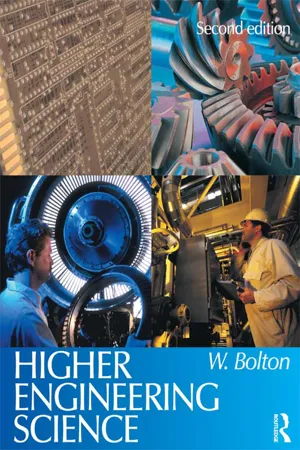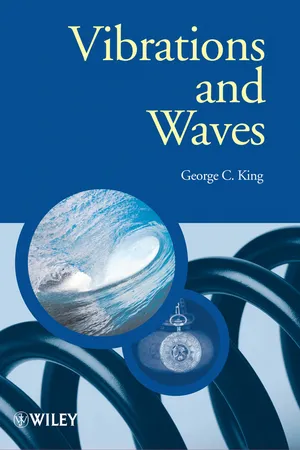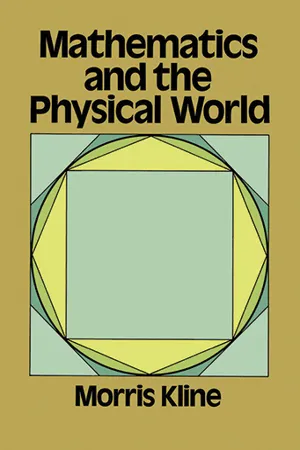Physics
Oscillations
Oscillations refer to repetitive back-and-forth movements or fluctuations around a central point or equilibrium. In physics, oscillations are commonly studied in the context of wave motion, pendulum motion, and harmonic motion. They are characterized by a periodic variation of a physical quantity, such as displacement, velocity, or acceleration, and are described using concepts like amplitude, frequency, and period.
Written by Perlego with AI-assistance
Related key terms
Related key terms
1 of 4
Related key terms
1 of 3
5 Key excerpts on "Oscillations"
- eBook - ePub
- A. L. Stanford, J. M. Tanner(Authors)
- 2014(Publication Date)
- Academic Press(Publisher)
8Oscillations
Publisher Summary
This chapter discusses oscillation, which is a back-and-forth motion over the same path. If an oscillating object executes each cycle, or repetition of its motion, in equal intervals of time, the motion is said to be periodic. The motion of a pendulum of a clock is an example of periodic oscillation. It is particularly instructive to relate the simple harmonic motion of a particle to circular motion. A particle moving in a circular path at constant speed is in periodic motion. In particular, the frequency of the oscillation does not depend on the amplitude of the oscillation. This important characteristic of simple harmonic oscillators means that if a mass oscillating is started by extending the spring to which it is attached to any length before releasing it, the system will oscillate at the same frequency. The independence of the frequency or period and the amplitude means that identical oscillators, extended different distances from equilibrium and released simultaneously, will reach the equilibrium position simultaneously.An oscillation is a back-and-forth motion over the same path. If an oscillating object executes each cycle , or repetition of its motion, in equal intervals of time, the motion is said to be periodic . The motion of a pendulum of a clock is an example of periodic oscillation. In this chapter we will concentrate on the simplest form of periodic oscillation, called simple harmonic motion, in which oscillatory motion takes place along a straight line. Simple harmonic motion plays a fundamental role in several areas of physics, and it is associated with several topics that are covered in subsequent chapters of this text.Idealized systems that execute simple harmonic motion are the primary considerations of this chapter. A discussion of quantities that characterize simple harmonic motion will be followed by a detailed kinematic analysis of that kind of motion. Then we will consider the dynamics of ideal oscillators, relating the forces that cause simple harmonic motion to the motion itself. Energy considerations will complete our analysis of idealized oscillators. - Tamer Bécherrawy(Author)
- 2013(Publication Date)
- Wiley-ISTE(Publisher)
Chapter 1Free OscillationsIn this chapter we introduce the basic notions of free Oscillations. Starting with a study of the differential equation governing the undamped vibrations, its general solution and its trigonometric, complex and phasor representations, we then progress to the equation of damped Oscillations and its solutions. We analyze some simple oscillating systems with one degree of freedom by emphasizing the notion of energy which, in modern physics, is considered to be a more fundamental quantity than forces. We generalize these results to systems undergoing small displacements or variations of the state “back-and-forth” near an equilibrium position. Afterwards, we analyze systems with two or several degrees of freedom.1.1. Oscillations and waves, period and frequency
Vibrations or Oscillations are motions or changes in the state of physical systems back-and-forth on both sides of an equilibrium position that are repeated more or less regularly in time. Waves are vibrations that propagate from one region to another. We encounter vibratory and wave phenomena in almost all branches of physics: mechanics, geophysics, electromagnetism, optics, quantum physics, etc. We consider in this book two kinds of vibrations: mechanical vibrations (of a pendulum, a string, etc.) and electromagnetic vibrations (of electric circuits, radio waves, etc.).Vibrations are free if, after an initial excitation, the system oscillates subject to its own internal forces but no-external forces. On the other hand, the vibrations are said to be forced if the external force continues to sustain the oscillation of the system. The external force is called the driving force .Vibrations of a system are periodic if the system returns exactly to the same state after each time interval T, called the period of vibration. Any physical quantity u of the system takes the same value after time intervals T, 2T, 3T, etc. Figure 1.1a shows the variation of a periodic function u- eBook - ePub
- William Bolton(Author)
- 2012(Publication Date)
- Routledge(Publisher)
6 Mechanical Oscillations 6.1 IntroductionThis chapter is about mechanical Oscillations; obvious examples of such Oscillations are those of a mass suspended from the end of a vertical spring (Figure 6.1(a) ), the Oscillations of a loaded cantilever (Figure 6.1(b) ) and the angular Oscillations of a simple pendulum (Figure 6.1(c) ). Basically we can think of all mechanical objects as having mass and elasticity and being capable of Oscillations. Such Oscillations often can be detrimental and result in the failure of machine parts, excessive wear or just undesirable noise.Figure 6.1 Examples of mechanical oscillation systems6.1.1 Basic terms The following are basic terms used to describe Oscillations:1 Periodic time, cycle and frequency Oscillatory motions are periodic, i.e. they keep on repeating themselves after equal intervals of time (Figure 6.2 ). The time between repetitions is called the periodic time and the oscillatory motion occurring within one period is called a cycle. The number of cycles per second is called the frequency. Thus, since one cycle occurs in the periodic time T, the frequency is 1/T.Figure 6.2 A periodic oscillation2 Free Oscillations and natural frequency The term free oscillation is used when an elastic system oscillates under the action of forces inherent in the system itself with there being no externally applied forces. For example, with the spring system in Figure 6.1(a) when it is given an initial deflection to start the oscillation and then left to freely oscillate. The system will oscillate at, what is termed, a natural frequency, such frequencies being determined by the properties of the system.3 Forced Oscillations Oscillations which take place under the effect of externally applied periodic forces are called forced Oscillations. Thus if the support of the spring system in Figure 6.1(a) - eBook - ePub
- George C. King(Author)
- 2013(Publication Date)
- Wiley(Publisher)
3
Forced Oscillations
So far we have considered free Oscillations where a system is disturbed from rest and then oscillates about its equilibrium position with steadily decreasing amplitude, as when we strike a bell. We now turn our attention to forced Oscillations where we apply a periodic driving force to the system. We are surrounded by examples of such forced Oscillations. We give a push to a playground swing at regular intervals to sustain its motion. In a pendulum clock the escapement mechanism gives regular impulses to the pendulum and in an analogous fashion the crystal in a crystal-controlled clock receives regular electrical impulses to maintain its oscillation. A musician uses a bow to play a note on a violin while air is driven into the pipes of an organ to sustain a note. (By contrast a harp and a guitar are plucked instruments and provide examples of free Oscillations.) On a much larger scale the moon exerts a gravitational pull that exerts a periodic driving force on the oceans of the Earth that strongly influences their tidal motion. At the microscopic level, the radiation in a microwave oven drives the electrons of the water molecules in the item being cooked.Forced Oscillations are the subject of the present chapter. We will see that the system always oscillates at the frequency of the applied force, apart from an initial transient response . We will see that the frequency of the applied force has a dramatic effect on the amplitude of the Oscillations, especially close to the natural frequency of the system. For example, a singer can cause a wine glass to shatter when they produce a note that is at the resonance frequency of the glass (the frequency you hear when you tap the glass). The shaking of the ground in an earthquake may cause a building to collapse. The important point is that a periodic force can produce large and possibly catastrophic effects when applied at the resonance frequency. We will see that the sharpness of the response to the applied force depends on the quality factor Q - eBook - ePub
- Morris Kline(Author)
- 2012(Publication Date)
- Dover Publications(Publisher)
18: THE MATHEMATICS OF OSCILLATORY MOTION Ut tensio, sic vis. —ROBERT HOOKETHE motions of projectiles, of planets, and of light have an obvious importance or attraction, and one would therefore hardly question why men should study these motions. On the other hand, the motion of an object suspended from a spring and bobbing up and down repeatedly seems to offer no more attraction than to while away an idle hour. Of course an idle mind readily becomes the devil’s playground, but we shall tempt the devil.Let us be clear first as to what is different about the motion of objects on springs as compared with the motions we have previously examined. A projectile shot from a cannon traverses its course to the target and stops there. It does not then reverse its motion and return to the cannon. In fact it is apparently so pleased to have completed its motion that it announces its arrival at its destination with a bang. Some motions are never completed but continue indefinitely in one direction. Thus the earth, after completing one revolution around the sun, does not stop and then move in the opposite direction. Projectiles and planets move, so to speak, along one-way streets. On the other hand, the object bobbing up and down in response to the force exerted by the spring travels back and forth endlessly. The object goes nowhere in this oscillatory motion; yet the study of such motions has carried man far in his scientific travels.Historically, the investigation of oscillatory motions was motivated by the desire to improve methods of telling time. The primary standard of time is, of course, the motion of the earth around the sun, but this natural clock is not particularly useful in the daily affairs of man. In the seventeenth century the need to measure small periods of time accurately for the purpose of telling longitude at sea caused scientists to search for increasingly accurate clocks. The search resulted in some major successes that were at least as valuable for the advancement of mathematics and the study of other phenomena of nature, such as light and sound, as they were for the specific problem of measuring time.
Index pages curate the most relevant extracts from our library of academic textbooks. They’ve been created using an in-house natural language model (NLM), each adding context and meaning to key research topics.
Explore more topic indexes
Explore more topic indexes
1 of 6
Explore more topic indexes
1 of 4




